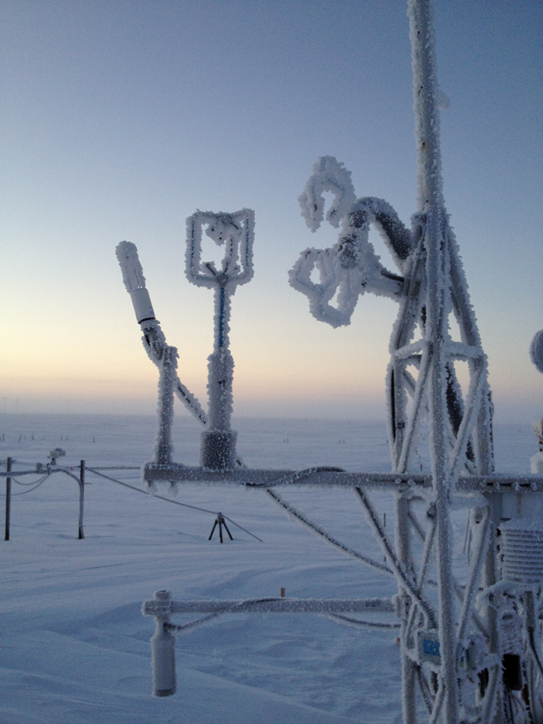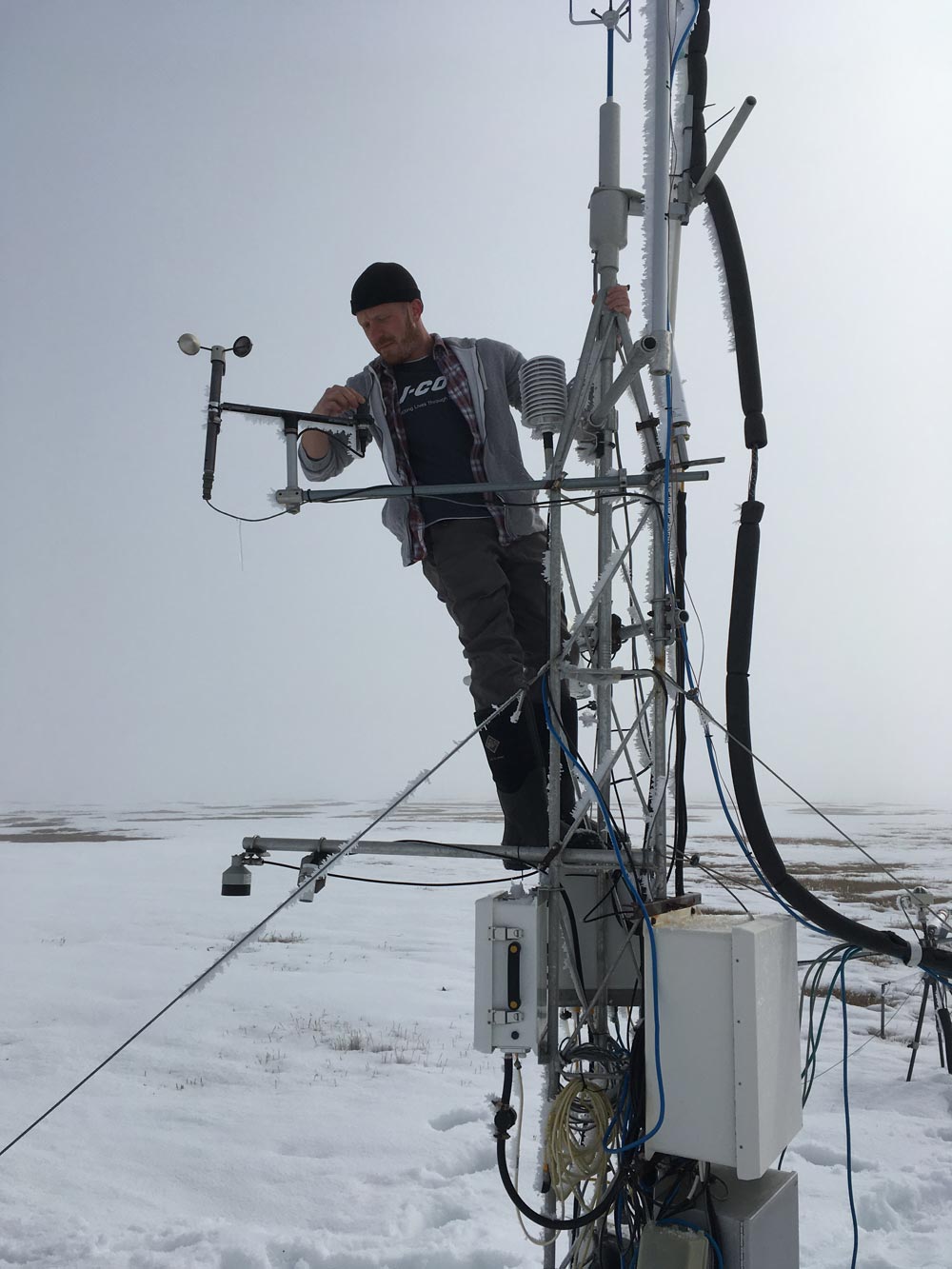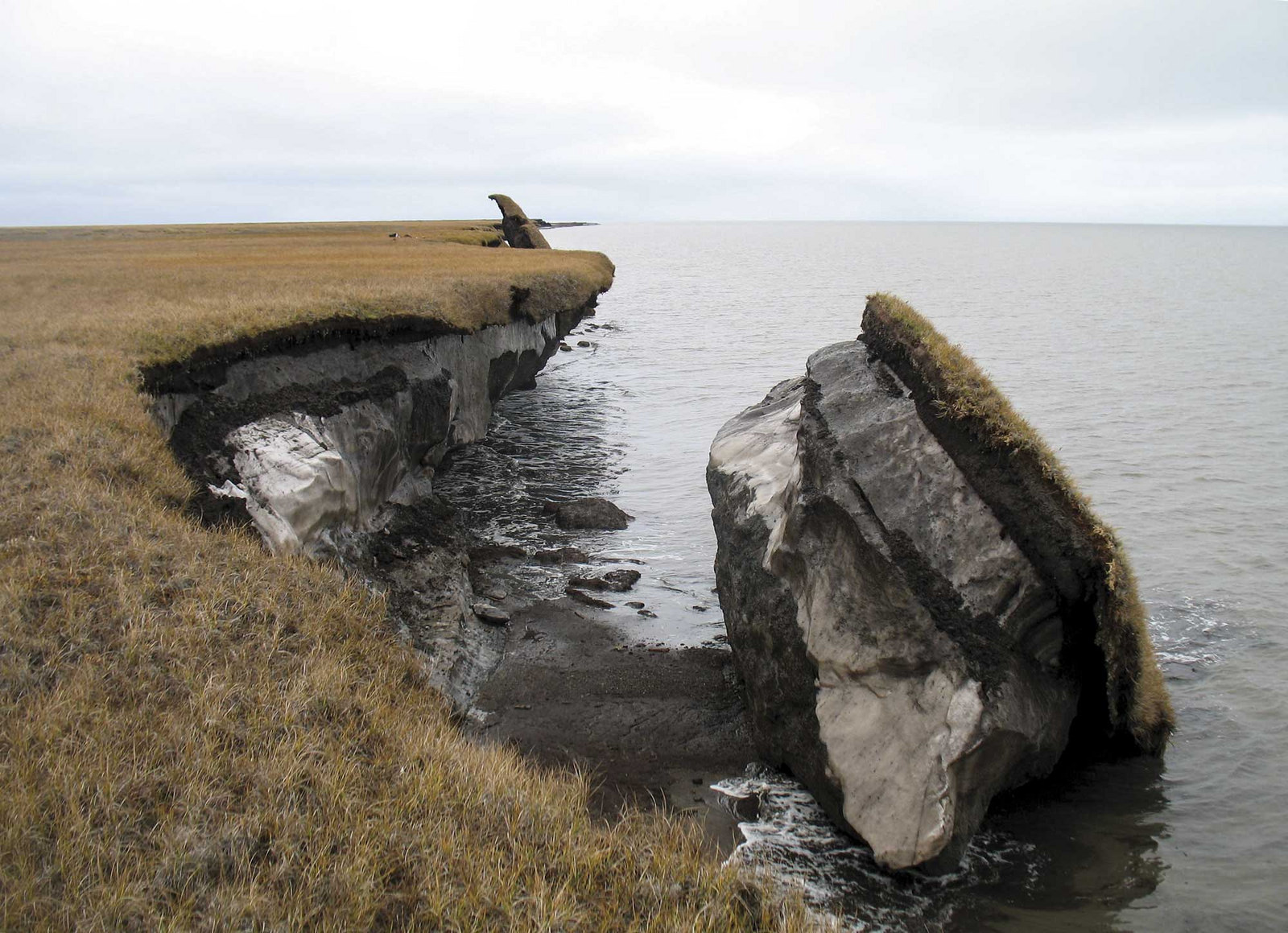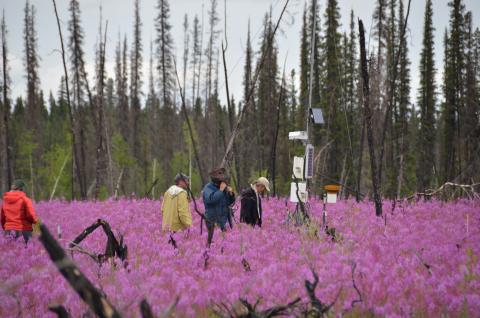Global Warming's Frozen Giant
Global Warming's Frozen Giant
Scientists are braving Arctic winters to study carbon frozen in soil. They keep finding surprises -- all of them bad.
Friday, February 16, 2018 - 11:15
(Inside Science) -- It was dusk when Nikita Zimov limped to the icy riverbank and its lifesaving supply of driftwood. He had pushed himself hard the last few exhausting miles, knowing that he would freeze to death if he didn’t find firewood before dark. He built a fire and huddled by the flames, trying to dry his sodden clothes as snow continued to fall. He peeled off one boot to expose his throbbing toe, and saw that the nail was bruised and broken from a day spent struggling across the tundra.
If it were summer, he'd have taken a boat upriver to his destination -- a patch of Siberian tundra where instruments monitored the flow of greenhouse gases between air and soil. In winter, he'd have taken a snowmobile over the ice. But in mid-October of 2014, the river was half-frozen. To maintain his instruments, he had to hike in from another direction.
The field site was on the outskirts of a swath of tundra known as the Pleistocene Park, which spans more than 50 square miles of mostly unfenced wilderness. As director of the park, Zimov was intimately familiar with the landscape and its dangers. Nevertheless, he had gotten turned around, and now was even farther from his goal than he had been when he started.
His swollen toe would not fit back in his hiking boot. If he couldn't hike on that foot the next day, he could still die before reaching his field site. But he had a spare pair of rubber boots in his backpack, so he figured he would manage. He emptied the backpack and lay on top of it, setting his spare boots by the fire.
When dawn came, it revealed a terrible sight.
"Those rubber boots are extremely flammable, apparently," said Zimov. "The front where the toes are, everything was burned."
Zimov is one of a handful of intrepid scientists who endure difficult Arctic conditions year-round to learn what's really happening to carbon frozen in the soil. Zimov's research is part of an ambitious project to restore an ice-age ecosystem, which he hopes will help lock carbon in the ground and slow the release of greenhouse gases. Other scientists are monitoring the flow of carbon on unmanipulated tundra, or on artificially warmed patches that simulate what will happen as the climate continues to warm.
Together, this research is revealing surprises. Thus far, all of them are bad. In a worst-case scenario, billions of tons of greenhouse gases could be escaping from northern soils every year, representing a significant fraction of what humans are already releasing through fossil fuel combustion. The large-scale climate models on which United Nations climate experts base policy recommendations don't yet take these additional greenhouse gas emissions into account.
Nikita.JPG
Nikita Zimov with a sedated baby musk ox. Zimov transported musk oxen into the Pleistocene Park in 2010 as part of an effort to restore an ice-age ecosystem.
Courtesy of Nikita Zimov
An unknown threat
The organic molecules that make up living things are full of carbon, and when living things die, that carbon returns to the environment.
In warm places, bacteria and fungi usually transform most of it into carbon dioxide or methane, both greenhouse gases that contribute to climate change. But when it's cold, dead things rot slowly.
Permafrost regions in the Arctic and on mountaintops have been burying dead things for tens of thousands of years, and researchers estimate that their soils now hold twice as much carbon as Earth's entire atmosphere. Most of this soil carbon remains perpetually frozen. Each summer, the top layer thaws, allowing decomposers to break down its stored carbon and release that carbon into the air.
As the climate warms, permafrost soil is thawing deeper and staying warm longer. The far north is warming twice as fast as the planet as a whole, with an increase of more than one degree Fahrenheit per decade in the last 30 years. Many researchers anticipate that the warmer it gets, the more soil carbon will be released.
But researchers have struggled to predict just how much carbon will escape to the atmosphere and how it will affect the climate. Some of the released carbon will be taken up by plants, which are expected to flourish in the longer, warmer growing seasons. And while researchers have measured the balance between plant growth and soil carbon release in a few locations, that doesn't automatically translate into a clear picture of the entire region.
To see the big picture and project future conditions, researchers rely on mathematical models of climate and Earth processes that simulate all the forces at work. Policymakers and climate scientists use these projections to set emissions targets -- goals they believe humanity must achieve in order to avert climate catastrophe.
But compared to other climate processes, Arctic soils have been a big black box, without enough data to model accurately. The Intergovernmental Panel on Climate Change, a major United Nations effort to summarize climate change knowledge for policymakers, stated in its latest report that "confidence is low regarding the sign and magnitude of future high-latitude land carbon response to climate change." None of the large-scale climate models used in the report took permafrost carbon into account.
"We always knew that the permafrost carbon pool was like a ticking bomb," said Abhishek Chatterjee, a carbon cycle scientist with NASA and the Universities Space Research Association in Greenbelt, Maryland, who is working to incorporate soil processes into the Geos-5 Earth System model.
A brutal landscape
Some of the data Chatterjee and other modelers need can be gathered remotely. For example, satellites can map vegetation by its greenness, and in 2015 NASA launched a new satellite that can measure liquid moisture in the top 2 inches of soil. But other crucial measurements must be gathered in person.
An anemometer frozen solid at Barrow, Alaska. The photo at the top of this article shows Zona's modified anemometer in action. Image Credit: Salvatore Losaccobbafmkcekccoggjf.png

Ice-busting innovations
Some of the Arctic's challenges can be conquered with grit and willpower, but others call for a creative touch. For example, how do you keep heat-sensitive instruments free of frost?
Donatella Zona, an Arctic ecologist at San Diego State University, leads a team studying the flow of carbon year-round in Alaska. In addition to measuring the concentrations of carbon dioxide and methane, she measures the speed and direction of wind that carries those gases between atmosphere and soil, using a device called an anemometer. The type of anemometer she uses works by bouncing sonic pulses between sensors oriented in different directions and detecting how much the wind slows or speeds each pulse's arrival.
If left on its own in an Arctic winter landscape, a standard anemometer will soon become smothered in spiky frost. A company called METEK sells a version with a built-in heater, but when Zona and her colleagues tried it, they found that the heat itself altered the wind currents they were trying to measure.
The solution came when they realized that they didn't need to keep the instrument hot all the time. Instead, they modified the heating unit to switch on only when needed, discarding the data from the heated periods. This left them with an hour or two of frost-melt time every couple of days, and solid data the rest of the time.
"Our modification allowed us to keep the instruments ice-free during the cold period," said Zona. "It was the thing that allowed us to operate year-round from these multiple sites, and get these datasets that are nearly unique."
Measuring wind in the frozen north could soon become easier for other teams as well, because a company called Campbell Scientific is working to incorporate the advance into a commercial product, said Zona. But despite such advances, she added, the instruments still need tending -- and that takes people willing to brave the cold.
It's no wonder that such data are scarce. Research sites are often remote and hard to access, and working conditions can be brutal, especially in the dark of winter.
"At minus 40, metal is brittle. It breaks," said Róisín Commane, an atmospheric scientist at Harvard University in Cambridge, Massachusetts. "Stuff can go horribly wrong."
Some of the hardest parts, according to terrestrial ecologist Eugénie Euskirchen at the University of Alaska Fairbanks, involve trying to perform delicate tasks with glove-encased fingers. Under no circumstances must you touch cold metal equipment directly.
There are surprising dangers, too, such as the rabid Arctic foxes that roam field sites near Barrow, Alaska.
"I used to get left at my site with a shotgun and told to 'shoot the smiling foxes,'" Chelsea Thompson, an atmospheric chemist with the National Oceanic and Atmospheric Administration and the University of Colorado Boulder, wrote on Twitter. Rabies often makes animals bare their teeth in a grim parody of a smile.
Data from the air
Much of the data that must be gathered in person involve air chemistry measurements at various heights above the Earth, from ground level to 16,000 feet up. For example, some researchers use devices known as eddy flux towers, which lift instruments just high enough to get above the local plant life. Most eddy flux towers in the Arctic are only used in summer, but in recent years, a few researchers have gone to enormous lengths to keep them running year-round. It was an eddy flux tower that Nikita Zimov was aiming for when he got lost in the Siberian wilderness.
Until recently, researchers expected that carbon release would slow to a trickle or stop altogether when it got cold, said Commane. Instead, they have found that both carbon dioxide and methane continue to escape during the cold seasons.
Arctic soils produce large amounts of carbon dioxide during the fall and early winter, long after air temperatures drop and plants stop absorbing the gas. At some sites, including the two Zimov monitored in Siberia, the fall and early winter emissions appear to cancel out the amount absorbed by summer plant growth almost exactly, resulting in little net change to the atmosphere. But in other places, cold season emissions dwarf what plants can take up.
For example, in a 2017 paper in the journal Ecosystems, Euskirchen and colleagues reported year-round eddy flux data from three Alaskan ecosystems that together represent half of the Alaskan tundra. All three sites released more carbon than they took in, with the most extreme site losing about 1.23 pounds of carbon per square yard over eight years. That's three or four times what the researchers were expecting, said Euskirchen.
How can the microbes that produce carbon dioxide stay active during the Arctic winter? Part of the answer is that they are well adapted to the cold, said Euskirchen. But the real key is that soil doesn't instantly freeze as soon as the air temperature drops. Instead, it hovers near 32 degrees Fahrenheit until all its stored heat is dissipated.
This period, known as the "zero curtain," has been getting longer. It now stretches up to 100 days at some sites, while it is thought to have lasted two to three weeks historically, according to Euskirchen. Decomposers work like gangbusters during the zero curtain, only slowing down when they are encased in ice.
The lengthening zero curtain appears to be having profound effects on carbon dioxide emissions over time. In a 2017 study, Commane and her colleagues compared the most recent decade's carbon dioxide emissions from the north slope of Alaska between October and December with emissions during the same months in the 1970s and '80s, and found that the emissions had risen by 73 percent. The data came from a large instrument tower run by NOAA near Barrow, Alaska -- one of the only Arctic field stations researchers have managed to operate continuously for decades.
Methane release in the cold seasons also appears to be much higher than previously thought, although for different reasons, said Zona. Methane-producing microbes release small amounts of methane year-round, even in the depths of winter. Because most of the year is cold, the methane released during Arctic cold seasons actually adds up to more than the amount released during the brief summer. And while soils release far more carbon dioxide than methane, the latter is a much more powerful greenhouse gas, so even small amounts can potentially be important for the climate.
Before studying cold season emissions, researchers had pretty good estimates for how much carbon was going into plants and soil, said Commane. But, she said, "our calculation for how much was going out was woefully inadequate."
Cold season emissions have not yet been incorporated into climate and earth system models. In fact, said Chatterjee, most of the models that try to simulate Arctic carbon cycles shut down all soil emissions as soon as the air temperature drops below freezing.
IMG_0533_0_crop.jpg

Josh Hashemi works on an eddy flux tower in Alaska.
Kyle Arndt
Data from the ground
Other key measurements come from the ground itself. In a study published in 2016 in the journal Nature, Tom Crowther from the Netherlands Institute of Ecology and his colleagues combined data from 49 experiments across North America, Europe and Asia where scientists were artificially warming the soil. By comparing carbon content in the top 4 inches at warmed and unwarmed plots, the researchers could get a sense of how much carbon the different sites would lose or gain due to rising global temperatures.
Crowther expected to see some carbon loss from northern sites, but he thought that increased plant growth in warmer regions would balance it out. Instead, he found that the top few inches of soil across the globe was releasing an estimated 1 to 1.5 billion metric tons of carbon per year, nearly all of it from Arctic and sub-Arctic soils. At expected rates of global warming, that will mean 55 billion tons of carbon by the year 2050, about 12 to 17 percent of what researchers expect human activities to emit over the same period.
"We were amazed -- astonished -- to find not only that carbon loss is happening in certain areas, but it's a huge amount of soil carbon," said Crowther, who is a global change ecologist at ETH Zurich. "It's equivalent to having another industrialized United States on the world."
Shocking though those findings are, they doubtless underestimate the true magnitude of soil emissions, said Crowther. That's because the study ignored all soil deeper than 4 inches.
Ted Schuur at the Center for Ecosystem Science and Society at Northern Arizona University in Flagstaff has been looking at deeper soils, and the news is not good. Since 2009, he and his team have been tracking soil changes in plots of land near Denali National Park in Alaska, with some plots passively warmed using piles of snow that insulate the ground in winter. The summer thaw is reaching deeper year by year, with increases of about 4 inches in control plots and 14 inches in warmed plots from 2009 to 2015.
These deeper thaws are exposing more and more stored carbon to decomposition. But when Schuur's team first tried to measure the carbon loss using standard methods, they couldn't detect any change.
The standard method involves drilling a soil core to a certain depth, then comparing it with another sample of the same depth taken at a later date. This fixed depth method works fine in most soils, said Schuur, but permafrost is largely composed of ice. When it thaws, that ice melts and flows away, making the ground collapse. Thus, when a researcher returns to the same location and digs to the same soil depth, the later samples will include soil layers that used to be further down in the earth.
To correct for this problem, Schuur and his colleagues incinerated their soil samples, burning off organic matter until nothing was left but ash. This let them compare the concentration of carbon relative to noncombustible minerals, independent of the total soil volume.
The ash-corrected measurements showed that the warmed plots had lost a quarter of their carbon in just five years. The loss was primarily from depths of 13-22 inches, well below the 4-inch limit of Crowther's study. Schuur presented the findings in December at the American Geophysical Union meeting in New Orleans.
To the best of Schuur's knowledge, the ash correction method has never before been used with permafrost soils. That could mean that past experiments in other parts of the Arctic may have missed big carbon losses.
Extrapolating from ash-corrected measurements and global warming projections, Schuur estimated that soils at his site in Alaska could lose two-thirds of their carbon by the end of the century. Previously, he had estimated that Arctic soils as a whole would lose just 5 to 15 percent of their carbon stocks in the same time frame.
The next step is to scale up measurements from places like Schuur's field site into models that show planetwide impacts. But the Arctic is huge and diverse, and reflecting its overall behavior is no easy task.
32682616471_bb04f90ad2_h.jpg

Ice-rich permafrost collapses on the edge of an eroding coastline near Drew Point, Alaska.
U.S. Geological Survey via Flickr
"The amount of carbon in two samples of soil can be incredibly variable even 2 centimeters, let alone 2 meters or 2 kilometers apart," said Crowther. According to Chatterjee, the smallest scale current global models operate at is 14 kilometers.
For now, Chatterjee can't say how much carbon the Arctic will release, or even whether it will release more than it absorbs. Nevertheless, he said, there are several reasons to think that modelers may have underestimated the true problem. In addition to ignoring fall and winter emissions, most models only look at the top layers of soil, ignoring carbon stored deeper in the ground. If other permafrost regions behave the same way as Schuur's site, those deeper layers could be an even greater threat than what's on the surface.
"For the first time we are able to actually quantify the loss that you see from what [Schuur] called the mineral layer, or the middle layer of soil," said Chatterjee. "It's absolutely clear that we have never accounted for that in any of the modeling frameworks that we have done."
Thin ice
The morning after his night on the Siberian tundra, Nikita Zimov uncurled from the remains of his fire and resumed his trek, sock-clad toes poking out the front of his burned boot.
Later that day, he reached his field site -- free of frostbite, although the nail of his injured toe would remain black for a year. He spent the next three days seeing to his instruments, then faced the challenge of getting home.
It was colder than it had been when he'd left the park's research station five days before. The river ice was deeper. Hoping for the best, he set out on a snowmobile, sticking to the edge of the river where the ice was thickest.
At long last, he came in sight of the research station, a cluster of houses in warm shades of gold and orange. He had to cross the river to reach it. Steeling himself, he gunned the accelerator and sped across 300 yards of fresh ice.
At the far shore, he stopped and looked back. All along the path he'd taken, the river was collapsing into bobbing shards. The snowmobile's roar had hidden the sound of cracking ice.
fluxtower.jpg

Researchers monitor an eddy flux tower near Fairbanks, Alaska. The tower is located in a burn scar that fills with fireweed flowers in summer.
NASA / Peter Griffith
There aren't many people willing to brave such conditions to study carbon in the Arctic. But thanks to researchers like Zimov, we are starting to get a consistent picture of a threat that could be global in scale. A massive hoard of carbon is escaping from frozen soils, potentially sending the climate even farther out of control.
"We underestimated the amount of CO2 that gets released," said Chatterjee. "We really do not know what the consequences for the planet will be."
Editor's note: This story was updated at 5:30 p.m. on Feb. 16, 2018 to correct the name of the company METEK.
Filed under
Republish
Authorized news sources may reproduce our content. Find out more about how that works. © American Institute of Physics


